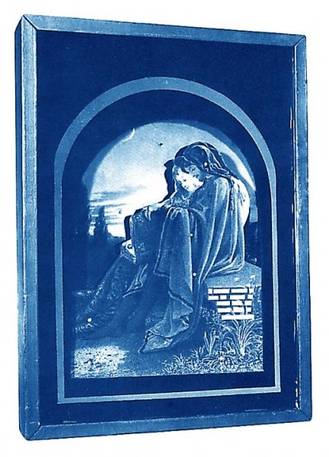I always like to walk through the San Francisco MOMA’s permanent photography exhibit when I'm there. Most recently I stopped by hoping to see one or two Tina Modotti [2] pieces, since the museum owns a number of good ones. They didn't have any of her work up this time (Modotti will crop up again in my posts, I'm certain), but I stumbled on quite a crowd at the Joseph Cornell exhibit, in its last day.
Cornell (1903-1972) had no formal training as an artist. He took everyday found objects—pieces of clothing, newsprint, toys—and made them look spectacular. His curio boxes are an amazing mix of surrealism and folk art; they each appear fresh, raw, and modern. At the same time, his detailed organizing of leftover odds and ends seems indebted to a Victorian sensibility, with its fixation on cataloguing and enumerating.
Cornell was from New York and was deeply influenced by European modern art movements, especially the Dadaist and surrealists. Most scholarship would call him somewhat of a Francophile, as
Adam Gopnik [3] put it, “[Cornell] didn't long to go to France; he longed to build memorials to the feeling of wanting to go France while riding the Third Avenue El.”
And yet as I walked through the exhibit I couldn't help but pick up some Italo-flavor in his pieces, albeit a subtle one. I was first struck by the way Cornell captures—literally, within walls and glass—an image from Dante's Inferno, choosing Canto V, the lovers Paolo and Francesca, and encapsulating them in a sullenly romantic blue-tinted moonlight. But he doesn’t stop with the ill-fated amanti.
One of his better-known series involves Renaissance portraits, evoked in particular by those of the Medici. He created a “Medici Slot Machine,” and with it managed to comment exceptionally succinctly on the way fortune, luck, and power played out in Renaissance Italy.

Finally, the transnational Italian migrant of the nineteenth century makes her way into his work as well, although in a guise quite different from the more standard peasant variety one might expect. Instead, Cornell takes a stab at the glamorous life of the Italo-Swedish ballerina Marie Taglioni, in his “Taglioni’s Jewel Casket.” He uses fabric, glass, and wood to create a Sheherazade-style myth out of Taglioni’s biography.
While the Cornell exhibit has closed at the SF MOMA, there are at least two other programs that might be of interest to i-italy readers: the documentary films of Emile de Antonio playing through the end of February and the SF MOMA-commissioned photos of Silicon Valley by Gabriele Basilico open in late January. A presto!




